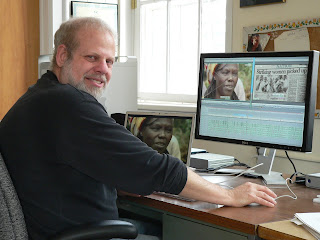
For armchair historians and Civil War scholars, 2009 is a banner year. The year marks the bicentennial birthday of Abraham Lincoln and the 150th anniversary of abolitionist John Brown’s raid on a federal arsenal in Harpers Ferry, West Virginia. National parks and historical sites in Pennsylvania, Maryland, West Virginia, and Virginia have organized events such as dramatic reenactments, tours, and symposiums through the end of the year to commemorate the raid, considered to be the spark that ignited the Civil War.
Here in Ohio, playwright Kay Reimers has taken her stage play, Sacred Fire, based on historical accounts of the wealthy and influential supporters of John Brown, and turned it into a radio drama. The one-hour drama will air on WYSO (FM 91.3) on Thursday, Oct. 22 (11 p.m.); Friday, Oct. 23 (7 p.m.); and Sunday, Oct. 25 (11 a.m. and 11 p.m.).
In the play, each of Brown’s key backers must wrestle with his or her own conscience as the far-reaching repercussions of their financial support slowly come to light. In Reimers’ trademark treatment of an historical drama, she asks the audience to wrestle with their conscience as well, posing the question, “Would you support a terrorist if the cause was just?”
“Theatre can be a very effective tool for teaching history,” said local actor Howard Shook in a recent interview with Living History Theatre members who staged the play at the Antioch Theatre in October 2007. Some of the tactics Brown employs to end slavery and punish ― even murder ― slavery supporters don’t sit well with Brown’s backers. That is, with the exception of Unitarian pastor, Rev. Thomas Higginson, played by Shook.
“Thomas Higginson would stand in the street and say, ‘Yes, I did. I gave money to John Brown,’ because he was very passionate about his beliefs,” Shook explained. So passionate that, according to the play, fellow supporters are forced to consider undermining Higginson in order to keep from being implicated in the treason charges brought against Brown and face possible execution themselves.
Just how far would John Brown’s supporters go to support their cause?
Jonathan Platt, who plays the role of Robert E. Lee, appreciates the re-evaluation of Brown that has taken place in recent history.
“In recent years, he’s reemerged as a more noble figure,” said Platt, referring to the “saint-or-madman?” debate that follows John Brown to this day and appears throughout the quad-state symposiums. “John Brown basically started the first white uprising of slavery and in that way, was way ahead of the time.”
In addition to the task of drawing parallels between historical and modern-day events, Living History Theatre members also had to bring history to life on radio after having brought it to life on stage.
“You’re standing there in front of a microphone and you can’t move and walk around,” said Shook, describing the difficulty of keeping his mouth directly in front of the microphone at all times while still maintaining a connection with the other actors.
“For me it was interesting learning how to convey everything with just my voice,” said Miriam Eckenrode whose character, Julia Ward Howe, is married to Samuel Gridley Howe, played by Doug Hinkley. Eckenrode appreciates the way in which Reimers portrays female characters who are strong, intelligent, and educated. “Julia could speak very directly and very honestly with her husband and he respected her opinion. Even though women were not considered equal yet, Kay writes the female characters with a lot of consideration for the relationship that they have with their husbands.”
Sectional rehearsals and scenes recorded out of sequence that would have driven another theatre company mad, were made conveniently possible with an all-local cast, playwright, and director. Director Dan Davis charted out each scene, then coordinated rehearsals for the relevant actors since only a few could fit in the recording studio at one time. During recordings, Reimers would stand at the window outside the WYSO studio, and watch history unfold.
“Dramas were once the mainstay of radio, but they mostly have disappeared,” said Reimers, recalling the winding path her play took to get from stage to studio. “When I looked for other [radio dramas] to read, I found almost nothing out there. I give a great deal of credit to the staff at WYSO for being willing to experiment. I feel that [Morning Edition Host] Jerry Kenney and [General Manager] Neenah Ellis, my co-producers, and I held hands, closed our eyes, and jumped into the deep end of the pool together.”
Reimers doesn’t need the upcoming WYSO broadcast of Sacred Fire to signal a closure to this effort. She’s already moved on to her next production, which will focus on the women’s suffrage movement of the 1920’s.
“For the actor, the ultimate validation is the applause from the audience,” said Reimers. “But for the writer, it’s seeing the work actually living. It’s no longer in your head, it’s no longer on a page. Writers tend to be shy people, we can get a little overwhelmed by applause and getting noticed. But to hear it in the recording studio ― that’s all the applause I need.”
For more information about the sesquicentennial anniversary, go to http://www.johnbrownraid.org
Originally published in the Yellow Springs News.
Susan Gartner is a freelance writer and photographer for the News.






